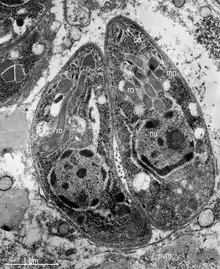細胞內寄生物
細胞內寄生物(英語:)是指一類寄生於宿主細胞中生長、繁殖的生物,可分為兼性(Facultative)和專性(Obligate)寄生物。部分細胞內寄生物會導致相關疾病的發生。
兼性寄生物
兼性寄生物可以在胞內寄生,於胞外也可以存活[1]。
屬於兼性寄生物的細菌舉例如下:
- 漢氏巴爾通體(Bartonella henselae)[2]
- 兔热病杆菌(Francisella tularensis)[3]
- 李斯特菌[4]
- 伤寒沙门氏菌(Salmonella typhi)[5]
- 布鲁氏菌属(Brucella)[6]
- 軍團菌屬[7]
- 部分分枝杆菌(Mycobacterium)[8]
- 诺卡氏菌(Nocardia)[9]
- 紅球菌(Rhodococcus equi)[10]
- 耶爾辛氏菌屬[11]
- 腦膜炎雙球菌(Neisseria meningitidis)[12]
屬於兼性寄生物的真菌舉例如下:
專性寄生物
專性寄生物只能在寄生細胞內存活,生活完全依賴於宿主細胞內的資源。
專性寄生物有:
對專性寄生物的研究難度較高,因為他們通常不能在宿主外增殖。2009年,研究人員發現Q型流感的病原體贝氏柯克斯体(Coxiella burnetii)可以在一種無菌培養基上培養。他們在論文中提出,這種技術也許亦可以應用在其他病原體上[18]。
營養
細胞內寄生物主要依靠宿主細胞的能量生長繁殖,他們尤其需要在脫離宿主細胞時難以獲取的營養物質。兼性細胞內寄生物嗜肺军团菌(Legionella pneumophila)目前是研究細胞內寄生物獲取宿主細胞營養的標準研究模型。目前的研究表明,嗜肺军团菌通過促進宿主細胞蛋白自我分解或通過蛋白酶體分解,將這些蛋白質變為氨基酸。嗜肺军团菌可以用這些氨基酸作為碳源和主要的能量來源[20]。
敏感性
T細胞功能受損的人群(如AIDS患者)較難清除侵入體內的病原性細胞內寄生物[21]。
參見
- 寄生蟲病
參考
- 李雍龍等. 第7版. 人民衛生出版社. 2009: 9. ISBN 978-7-117-09971-4.
- (PDF).
- Ryan KJ; Ray CG (editors). 4th. McGraw Hill. 2004: 488–90. ISBN 0-8385-8529-9.
- Dramsi, Shaynoor; Cossart, Pascale. . The Journal of Cell Biology. 2002-03-18, 156 (6): 943–946. ISSN 0021-9525. PMC 2173465. PMID 11901162. doi:10.1083/jcb.200202121.
- Jantsch, J.; Chikkaballi, D.; Hensel, M. . Immunological Reviews. 2011, 240 (1): 185–195. PMID 21349094. doi:10.1111/j.1600-065X.2010.00981.x.
- Celli, Jean. . Cellular Microbiology. 2015, 17 (7): 951–8. PMC 4478208. PMID 25916795. doi:10.1111/cmi.12452.
- W T Martin; 等. . Appl Environ Microbiol. 1984 Mar; 47(3): 467–471.
- Silva MT; 等. . Lancet Infect Dis. 2009 Nov;9(11):699-710.
- Beaman BL; Beaman L. . Subcell Biochem. 2000;33:167-97.
- Kelly, B. G.; Wall, D. M.; Boland, C. A.; Meijer, W. G. . Microbiology. 2002, 148 (Pt 3): 793–798. PMID 11882714. doi:10.1099/00221287-148-3-793.
- Yuehua Ke; Zeliang Chen; Ruifu Yang. . Front Cell Infect Microbiol. 2013; 3: 106.
- Spinosa MR, Progida C, Talà A, Cogli L, Alifano P, Bucci C. . Infect. Immun. July 2007, 75 (7): 3594–603. PMC 1932921. PMID 17470547. doi:10.1128/IAI.01945-06.
- Sebghati TS, Engle JT, Goldman WE. . Science. November 2000, 290 (5495): 1368–72. PMID 11082066. doi:10.1126/science.290.5495.1368.
- Alvarez, M.; Burns, T.; Luo, Y.; Pirofski, L. A.; Casadevall, A. . BMC Microbiology. 2009, 9: 51. PMC 2670303. PMID 19265539. doi:10.1186/1471-2180-9-51.
- Amann R, Springer N, Schönhuber W, 等. . Applied and Environmental Microbiology. January 1997, 63 (1): 115–21. PMC 168308. PMID 8979345.
- Deng, M.; Lancto, C. A.; Abrahamsen, M. S. . International Journal for Parasitology. 2004, 34 (1): 73–82. PMID 14711592. doi:10.1016/j.ijpara.2003.10.001.
- Page 28 in: Title: Rook's textbook of dermatology, Volume 4, Rook's Textbook of Dermatology, Tony Burns (FRCP.) Authors: Arthur Rook, Tony Burns (FRCP.) Edition: 8 Publisher: John Wiley and Sons, 2010 ISBN 1-4051-6169-8, ISBN 978-1-4051-6169-5
- Omsland, Anders; Cockrell, Diane C.; Howe, Dale; Fischer, Elizabeth R.; Virtaneva, Kimmo; Sturdevant, Daniel E.; Porcella, Stephen F.; Heinzen, Robert A. . Proceedings of the National Academy of Sciences USA. Mar 17, 2009, 106 (11): 4430–4 [September 18, 2011]. PMC 2657411. PMID 19246385. doi:10.1073/pnas.0812074106.
- Lynn Sagan. . J Theor Biol. 1967, 14 (3): 255–274. PMID 11541392. doi:10.1016/0022-5193(67)90079-3.
- Heuner K; Swanson M (editors). (2008). Legionella: Molecular Microbiology. Caister Academic Press.
- Page 432, Chapter 22, in: Jones, Jane; Bannister, Barbara A.; Gillespie, Stephen H. . Wiley-Blackwell. 2006. ISBN 1-4051-2665-5.
This article is issued from Wikipedia. The text is licensed under Creative Commons - Attribution - Sharealike. Additional terms may apply for the media files.
